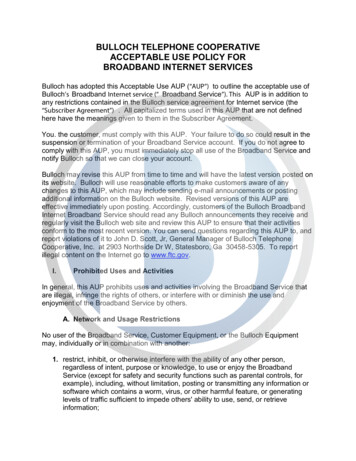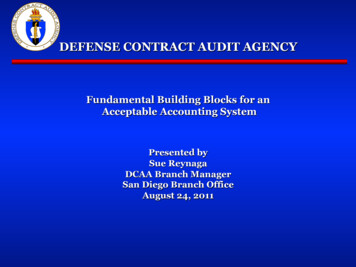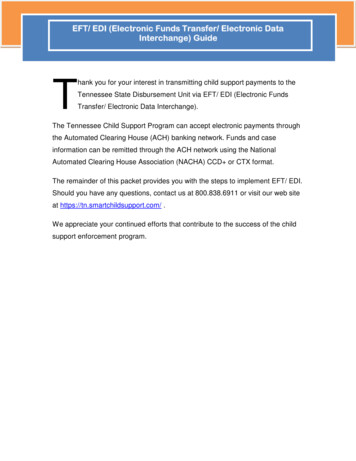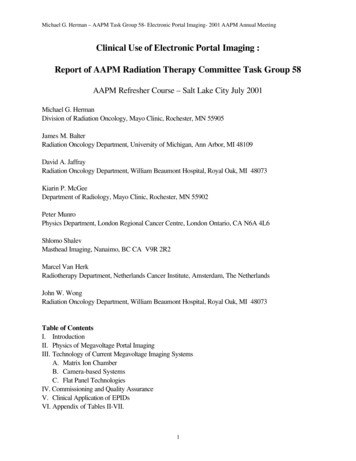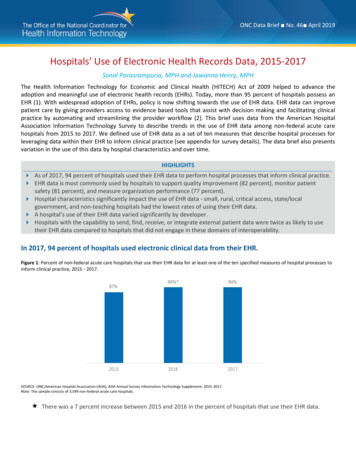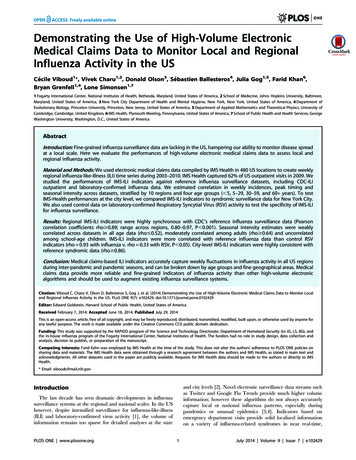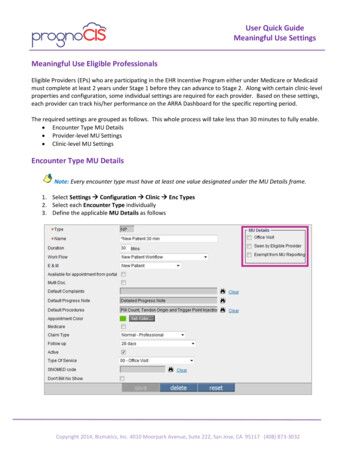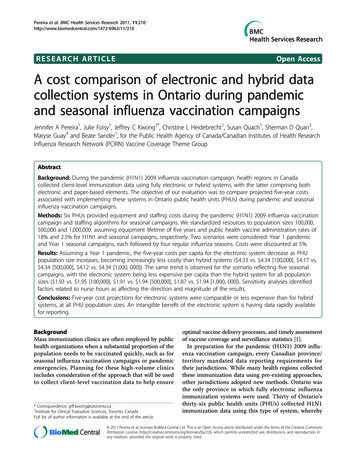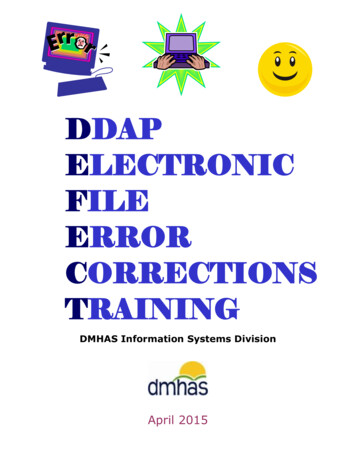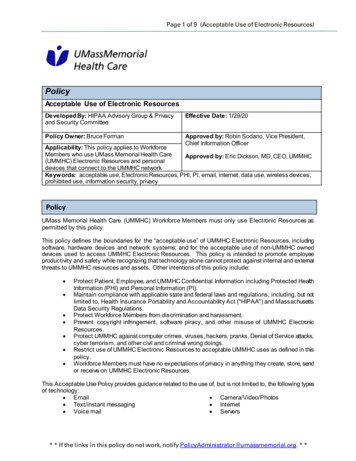
Transcription
Page 1 of 9 (Acceptable Use of Electronic Resources)PolicyAcceptable Use of Electronic ResourcesDeveloped By: HIPAA Advisory Group & Privacyand Security CommitteeEffective Date: 1/29/20Policy Owner: Bruce FormanApproved by: Robin Sodano, Vice President,Chief Information OfficerApplicability: This policy applies to WorkforceMembers who use UMass Memorial Health CareApproved by: Eric Dickson, MD, CEO, UMMHC(UMMHC) Electronic Resources and personaldevices that connect to the UMMHC networkKeywords: acceptable use, Electronic Resources, PHI, PI, email, internet, data use, wireless devices,prohibited use, information security, privacyPolicyUMass Memorial Health Care (UMMHC) Workforce Members must only use Electronic Resources aspermitted by this policy.This policy defines the boundaries for the “acceptable use” of UMMHC Electronic Resources, includingsoftware, hardware devices and network systems; and for the acceptable use of non-UMMHC owneddevices used to access UMMHC Electronic Resources. This policy is intended to promote employeeproductivity and safety while recognizing that technology alone cannot protect against internal and externalthreats to UMMHC resources and assets. Other intentions of this policy include: Protect Patient, Employee, and UMMHC Confidential Information including Protected HealthInformation (PHI) and Personal Information (PI).Maintain compliance with applicable state and federal laws and regulations, including, but notlimited to, Health Insurance Portability and Accountability Act ("HIPAA") and MassachusettsData Security Regulations.Protect Workforce Members from discrimination and harassment.Prevent copyright infringement, software piracy, and other misuse of UMMHC ElectronicResources.Protect UMMHC against computer crimes, viruses, hackers, pranks, Denial of Service attacks,cyber terrorism, and other civil and criminal wrong doings.Restrict use of UMMHC Electronic Resources to acceptable UMMHC uses as defined in thispolicy.Workforce Members must have no expectations of privacy in anything they create, store, sendor receive on UMMHC Electronic Resources.This Acceptable Use Policy provides guidance related to the use of, but is not limited to, the following typesof technology: Email Camera/Video/Photos Text/instant messaging Internet Voice mail Servers* * If the links in this policy do not work, notify PolicyAdministrator@umassmemorial.org. * *
Page 2 of 9 (Acceptable Use of Electronic Resources) Desktops/WorkstationsMobile DevicesTelecommunication DevicesData Storage Devices SoftwareComputer networks (wired, mobileand wireless)DefinitionsComputing Devices – devices that have been evaluated and accepted by Information Services ascompatible with the network and that have approved software and security controls installed. ComputingDevices include Workstations, Mobile Devices, Data Storage Devices, and Network Devices.Confidential Information – data/information (whether in oral, written, electronic or any other form)related to the business of UMMHC (including but not limited to PHI, PI, finance and administration, humanresources, legal, clinical, and any other patient and research data), that is not freely disclosed; privateinformation that is entrusted to another with the confidence that unauthorized disclosure will not occur.Cyberbullying - is a form of bullying or harassment that is perpetrated using electronic forms of contact.Examples of cyberbullying include mean text messages or emails, rumors sent by email or posted onsocial networking sites, and embarrassing pictures, videos, websites, or fake profiles.Data Storage Device – a device for recording (storing) information (data). A storage device may holdinformation, process information, or both. Data Storage Devices include, but are not limited to, portablehard drives, USB drives, flash drives, and DVDs.Electronic Resources – includes all information technology related software, devices, systems, andmedia, including Computing Devices, Peripheral Devices, Telecommunication Devices, and WirelessAccess Points, either owned or managed by UMMHC, or accessed via FMD or Webmail.Follow Me Desktop (FMD) – UMMHC’s software application that allows authorized Workforce Membersto access the UMMHC network from a remote location.Intellectual Property – property rights created through intellectual and/or discovery efforts of a creatorthat are generally protectable under patent, trademark, copyright, trade secret, trade dress (e.g. theappearance or image of a product) or other law.Malicious Intent – includes but is not limited to any intentional act that knowingly violates UMMHCpolicies and/or local/state/federal laws and regulations as well as hacking, cracking, bugging, viruscreation/propagation, tampering with government or private data without authorization, and the intentionalnon-secure transmission of sensitive data across the internet or other non-secure network.Managed Device – any Computing Device, Peripheral Device, Telecommunication Device or WirelessAccess Point that is either owned by UMMHC or not owned by UMMHC, but is: Registered, approved and authorized by UMMHC to access, transmit or store UMMHCinformation for purposes of conducting UMMHC business, and Configured to meet UMMHC’s standards for security control, including as technically appropriatefor a device, but not limited to:o Centrally managed,o Encrypted,o Protected by anti-virus/malware software, ando Capable of having UMMHC content remotely wiped/deleted from the device.Devices that are not owned by UMMHC which are Managed Devices may have a portion of the devicethat is managed and another portion of the device that is non-managed. For example, a personallyowned smartphone may have software installed by UMMHC that segregates and protects UMMHC* * If the links in this policy do not work, notify PolicyAdministrator@umassmemorial.org. * *
Page 3 of 9 (Acceptable Use of Electronic Resources)information to one part of the smartphone, without interfering with the user’s personal information onanother part of the smartphone. Where this is the case, the term “Managed Device” will only apply to thatportion of the device that is managed by UMMHC.Mobile Device – an easily portable device that combines computing, telephone/fax, email and networkingfeatures. Examples of Mobile Devices include smartphones and tablets.Network Devices – are components, such as routers, switches, firewalls, and servers, used to connectcomputers or other electronic devices together so that they can share files or resources like printers or faxmachines.Non-Managed Device – is a non-UMMHC device or personally owned device that has not beenregistered, approved and authorized by UMMHC. Non-Managed Devices may only connect to the guestwireless network, FMD and Webmail.Personal information (PI) – an individual’s first name and last name or first initial and last name incombination with any one or more of the following data elements that relate to such individual: Social Security number; Driver’s license number or state-issued identification card number; or Financial account number, or credit or debit card number, with or without any required securitycode, access code, personal identification number or password, that would permit access to anindividual’s financial account; provided, however, that “Personal information” shall not includeinformation that is lawfully obtained from publicly available information, or from federal, state orlocal government records lawfully made available to the general public.Peripheral Devices – devices connected to Computing Devices to provide additional functions, such asprinting, copying, scanning, faxing and storing information. Examples of Peripheral Devices includecopiers, fax machines, printers, scanners and multifunction machines.Protected Health Information (PHI) – information created, transmitted, received, or maintained by theUMMHC Organized Health Care Arrangement (OHCA), including demographic information, related to the: Past, present, or future physical or mental health or condition of an individual; Provision of health care to an individual; or Past, present, or future payment for the provision of health care to an individual; together withany of the identifiers in the list below. Names (of patients, relatives,or employers)All geographic subdivisionssmaller than a StateAll elements of dates (exceptyear) including birth date,admission date, dischargedate, date of death; and allages over 89Telephone numbersSocial security numbersFax numbersCertificate/license numbersElectronic mail addressesVehicle identifiers and serialnumbers, including licenseplate numbersMedical record numbersHealth plan beneficiarynumbersAccount numbersDevice identifiers and serialnumbersWeb Universal ResourceLocators (URLs)Internet Protocol (IP) addressnumbersBiometric identifiers, includingfinger and voice printsFull face photographic imagesand any comparable imagesAny other unique identifyingnumber, characteristic, orcodePHI does not include information maintained about an individual by a UMMHC entity foremployment purposes, such as employee health records.* * If the links in this policy do not work, notify PolicyAdministrator@umassmemorial.org. * *
Page 4 of 9 (Acceptable Use of Electronic Resources) Note: Information for deceased individuals continues to be PHI until the individual has beendeceased for more than 50 years.Telecommunication Devices – a device used for the electronic transfer of information from one locationto another. Telecommunications or telecom refers to a mix of voice and data, both analog and digital.Examples of Telecommunication Devices include telephones, mobile phones, smartphones, and pagers.Text Messaging, or Texting – the exchange of brief Text Messages between mobile and/orsmartphones.Trusted Email Domain – an email domain of an entity outside of UMMHC, for example umassmed.eduand healthalliance.com for which UMMHC has established a permanently encrypted connection for thepurpose of sending and receiving email messages.Webmail – UMMHC’s software application that allows individuals with a UMMHC email account to accessthe UMMHC email network from a remote location.Wireless Access Points - is a networking hardware device that allows a Wi-Fi enabled device to connectto a wired network.Workforce Members – All employees, contractors, volunteers, trainees (including medical students,interns, residents, allied health professionals and business students), members of the medical staffincluding employed and private physicians, nurses in expanded roles, physician assistants, temporaryemployees, and other persons employed, credentialed or under the control of UMMHC whether or notthey are paid by UMMHC.Workstation - any desktop computer, VDI thin client, or laptop. In this context, Workstation is a genericterm for a user's machine used for UMMHC work. It may include one or more displays and otherPeripheral Devices such as a printer, monitor, external hard drive, etc.Required Criteria for ProcedureA. General Provisions1. All data created by Workforce Members on UMMHC systems is the property of UMMHC.2. UMMHC owned Electronic Resources are only for use by Workforce Members.3. UMMHC Electronic Resources will be used in compliance with applicable organizationalpolicies, standards, guidelines, state and federal regulations and laws.4. Workforce Members are to honor and respect all applicable intellectual property including, butnot limited to:a. Softwareb. Discoveriesc. Web content materialsd. Licensese. Digital certificatesB. Managed Devices1. Only Managed Devices may be used to store, process and/or transmit data used to supportthe clinical, administrative, research, educational and other business functions of UMMHC, orbe connected to UMMHC systems or networks other than as permitted by section C.1. below.2. Users of Non-Managed Devices may submit a request to have the device become a manageddevice by submitting an Exception to Desktop form. Contact the Support Center for anelectronic copy of the Exception to Desktop form.3. If security controls are not already present, Workforce Members will work with InformationServices to install UMMHC security controls on Managed Devices. Security controls mayinclude as technically appropriate for a device, but will not be limited to, the following:a. PIN* * If the links in this policy do not work, notify PolicyAdministrator@umassmemorial.org. * *
Page 5 of 9 (Acceptable Use of Electronic Resources)4.5.6.7.8.9.b. Lockout settingc. Encryptiond. Virus Protection on laptops and desktopse. Remote wipe for smartphones and tabletsOpen a ticket with the Support Center to request assistance from Desktop Services.Computer programs will not be installed onto any UMMHC Managed Device without I.S.approval and the installation may only be performed by approved individuals.Managed Devices must not be in an altered state such as “Jailbroken” iPhones or ‘Rooted’Android devices.Any Managed Device that is lost or stolen must be reported immediately to the I.S. SupportCenter.When a Workforce Member leaves or is terminated, or if the Workforce Member chooses tostop connecting his/her managed device to the UMMHC network, UMMHC data stored on thedevice must be removed (wiped) from the device by calling the I.S. Support Center.Device Reuse or Termination of Employment: To dispose of or reuse a M anaged Device,Workforce Members must open a ticket with the Support Center. Information Services willdetermine the appropriate process to disable access to the UMMHC network and to assure thesecure removal of any UMMHC information that may be on the M anaged D evice prior todisposal or reuse. Only performing a standard delete function may not be sufficient to cleansethe data. Desktop Services will update its inventory of Managed Devices to note the removal ofa Managed Device from the UMMHC network.Sending UMMHC Confidential Information to UMMHC display pagers is allowed, butmessage senders must limit confidential content to the minimum information necessary, andpagers must never be used to transmit patient care orders.a. Use of messaging through the electronic health record is the preferablecommunication method for non-urgent UMMHC Confidential Information.C. Non-Managed Devices1. Non-Managed Devices may connect to the UMMHC guest network, FMD and Webmail.2. Workforce Members using FMD to print when either on or off site must follow UMMHC Privacyand Information Security policies regarding physical security to prevent the printed materialfrom being inappropriately disclosed.3. Workforce Members using Webmail must follow the following safeguards:a. Never open attachments when using Webmail, since the attachments may be saved tothe Non-Managed Device used to open Webmail.b. Never save email or attachments when using Webmail.4. Never save UMMHC Confidential Information to a Non-Managed Device.D. Workstation Use1. Workforce Members will use the workstation locking capability (CTRL-ALT-DEL) wheneverleaving their workstation unattended. (Remember: “Control, Alt, Delete, when leaving yourseat.”)2. Remote control connection from one workstation to another, such as that used by InformationServices for remote troubleshooting, must be disconnected by the party that remotelyconnected to the workstation after the session is completed.3. Workforce Members will log off from their workstation(s) when their shifts are complete.E. Physical Security1. Laptops, Mobile and Data Storage Devices must be kept in the physical presence of the user orwhen left unattended on site stored out of sight in a locked office, locked drawer, locked closet,or cable lock. When taken off site, laptops, Mobile and Data Storage Devices must be kept inthe physical presence of the user or when left unattended locked out of sight such as in a cartrunk, home, or hotel room safe. Laptops, Mobile and Data Storage Devices must be moved tothe most secure site available at any given time. For example, a device must be removed from acar trunk when a user arrives at his/her home and secured in the locked home.* * If the links in this policy do not work, notify PolicyAdministrator@umassmemorial.org. * *
Page 6 of 9 (Acceptable Use of Electronic Resources)2. Workstations that are not laptops that are located on site in publicly accessible places willhave device locks installed.F. Email and Text Activities1. Email and other electronic material may constitute UMMHC records. Please see the UMMHCRecords Retention and Destruction Policy2. Email transmissions, both on the intranet and the internet, may be subject to disclosurethrough legal proceedings or as otherwise required by law.3. Some messages sent, received or stored on the UMMHC email system may constituteprivileged communications between UMMHC and its in-house or external attorneys. If youreceive an email labeled “Privileged Attorney-Client Communication” (or similar language), youshould seek the attorney’s permission before disseminating it further, as the privilege may bedestroyed if the transmission is sent to a third party.4. Always encrypt emails when sending emails containing Confidential Information outside theUMMHC trusted email domain. Emails are sent encrypted when the word secure is in theSubject line of the email. Be certain to always double-check all “to” and “cc” fields prior tosending any emails to determine if any recipients are outside of the trusted email domain. A listof trusted email domains may be found here: (Link to Be added) Limited exception: Anindividual may request to have their PHI sent unencrypted. Please see the Uses andDisclosure of Protected Health Information Policy for more information about this exception andrequired accompanying process.5. Confidential Information may be transmitted via email within UMMHC with minimal risk.6. When conducting UMMHC business, Workforce Members may only use their UMMHC emailaccounts. Use of a non-UMMHC email account, such as a Gmail, Hotmail, or an accountprovided by another entity, is not permitted. UMMHC email must never be forwardedautomatically to a non-UMMHC account.7. Occasional use of UMMHC email and electronic resources for personal reasons is permitted.8. Text Messages are not encrypted and therefore may not be used to transmit PHI. Usemessaging through the electronic health record for messages containing PHI.G. Internet Use1. The internet and all UMMHC electronic resources are to be used primarily in support ofUMMHC related patient care, business, and research activities.2. All copyright laws and regulations are in effect in the online environment.3. Users who violate copyright and/or license terms are personally liable for their actions.4. UMMHC utilizes an Internet content filtering tool which prohibits access to sites, including, butnot limited, those in the categories of: Adult Anonymizer Browser Toolbar (e.g. Google Instant Messenger Nudity Pop Up Web Advertisements Toolbar)DatingFile sharing SitesGamblingHate and RacismIllegal ChatInactive SitesOn-Line GamingPornographySpyware/Malicious SitesStreaming RadioWeapons5. UMMHC recognizes Workforce Members need to share documents with external users.Although email is a good method for communication, it is not always the best method for file* * If the links in this policy do not work, notify PolicyAdministrator@umassmemorial.org. * *
Page 7 of 9 (Acceptable Use of Electronic Resources)sharing. Drop Box is a file sharing site that UMMHC has approved for file sharing purposes.However, sharing files on Drop Box is only acceptable for de-identified data, resumes,presentations, or any document which does not contain UMMHC Confidential Information orIntellectual Property.H. Passwords and Device Authentication1. Individual passwords must be kept secret, never shared with anyone for any reason.Exceptions must be approved by the Chief Information Security Officer. If written down,passwords must be stored in a
UMass Memorial Health Care (UMMHC) Workforce Members must only use Electronic Resources as permitted by this policy. . Workstation - any desktop computer, VDI thin client, or laptop. In this context, W orkstation is a generic term for a user's machine used for UM MHC work. It may include one or more displays and other
